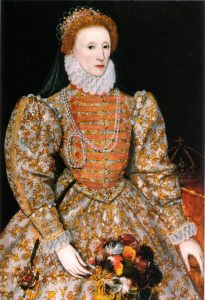Out of all of the Tudor monarchs, Elizabeth I was arguably the most successful in terms of being able to cultivate the image of a powerful ruler, giving her the power to set the standard for what a monarch should strive for. Elizabeth’s reign was welcomed after the death of her tyrannical sister, Queen Mary, and immediately imitated the behavior of her father and grandfather before him; she created an image of herself that resonated positively almost universally, giving her significant political power (Bezio). As a woman in the sixteenth century, Elizabeth was surrounded by men who believed that they could manipulate the young queen to achieve their own ends. The question of her marital status plagued her reign for years. In an attempt to force her into a marriage, and therefore an alliance and the key to continuing the line of succession, Parliament threatened to cut off her access to funding if she did not find a husband. In a stroke of wit and argumentative prowess, Elizabeth was able to not only retain access to Parliamentary funds, but also continued to keep Parliament out of her personal life, claiming that “’If I followed the inclination of my nature, it is this,’ she said, ‘beggar woman and single, far rather than queen and married’ (Briscoe).

She justified her reign through non gendered grounds. She established herself and the daughter of Henry VIII and like monarchs before her, she “emphasized the role of God in keeping her from danger and placing her on the throne”(Doran). The strategies that had been in her family for generations now continued to solidify the Tudor line, allowing them to continue to set the bar for future monarchs. Elizabeth’s reign is consistently considered the “Golden Age”, where she brought about prosperity and power. Future monarchs are often compared against her reign, and oftentimes fall short (Bezio). Her success as a ruler informed future monarchs because they want to embody the reign that she had, showing that the Tudor dynasty was integral to the work of future monarchs and how we look at the monarchy today.